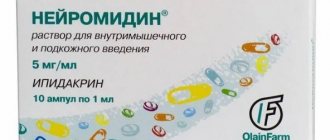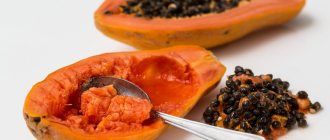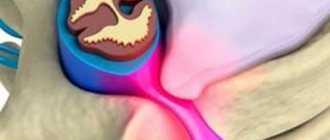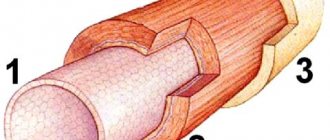Muscle relaxants are non-steroidal medications with targeted action. They are designed to eliminate muscle spasms, relax human skeletal muscles, and improve blood circulation. These drugs are taken when the patient needs to reduce acute pain.
Muscle relaxants for hernia of the lumbar spine
Remember: Taking such drugs without a doctor’s indication is strictly prohibited!
In the article we will talk about how such drugs work, in what cases they are prescribed and what contraindications they have.
Features of the work of muscle relaxants
Muscle relaxants are divided into two groups according to the direction of their action:
- Centrally acting muscle relaxants
- Peripheral muscle relaxants
Medicines in this group have several important properties. These include:
- High level of focus. The first type of medicine (central action) has the task of suppressing muscle activity (while the nerve impulses that are responsible for posture and muscle function continue to pass). When a person takes the drug, the spasm is relieved, and the muscles completely relax. Muscle relaxants of the second type (peripheral action) have another task - to interfere with the transmission of nerve impulses. However, when taking such drugs, negative consequences may occur in the form of problems with movement or loss of the ability to stand still.
- High level of tolerance by the body. Modern medicine is trying to ensure that muscle relaxants are easily accepted by the body and have fewer contraindications and side effects.
- Compatibility with other drugs. Muscle relaxants are not the only drugs prescribed by a doctor to a patient. They must combine well with other medications to increase the effect produced. The most effective treatment for spinal hernia has been shown by a complex of medications, which include both centrally acting muscle relaxants and non-steroidal anti-inflammatory drugs.
Scheme of action of muscle relaxants to understand the principle of operation
It is important to understand that, thanks to muscle relaxants, you can get rid of muscle spasms and reduce pain, but they cannot cure the hernia itself.
Find out what a blockade is for a hernia and why it is needed from our new article - “Blockade for a hernia of the lumbar spine.”
Prices for vitamins and minerals
Types of muscle relaxants
Based on the mechanism of action, there are two main types of muscle relaxants:
Central muscle relaxants are drugs that inhibit the central structures of muscle tone. These chemicals have a direct effect on the parts of the central nervous system, brain and spinal cord that are involved in the regulation of muscle tone. Peripheral muscle relaxants are agents that penetrate into direct neuromuscular transmission. These medications relax voluntary muscles by blocking the signal from the motor nerve to the muscle.
Possible side effects
Despite all the positive properties of muscle relaxants, they still have one “but”: muscle relaxants relax absolutely all muscles, which makes it difficult for a person to move. It also deprives the muscles of the body's protective function. For this reason, there is a dual situation when it comes to prescribing muscle relaxants: taking them can either improve the patient’s well-being or worsen it. Therefore, before using medications, you should consult your doctor.
Side effects cannot be avoided. You have to put up with them if you want to get better
Other side effects may occur:
- dry mouth;
- constant drowsiness;
- problems with urination.
Despite the side effects, this category of drugs is widely used in the treatment of intervertebral hernia.
Possible effects of muscle relaxants
Having a significant effect on the central nervous system, muscle relaxants can cause the following consequences for human health and well-being:
- lethargy and apathy;
- drowsiness;
- dizziness;
- nausea and vomiting;
- headache;
- arterial hypotension;
- muscle microdamage;
- convulsions and so on.
Long-term use of muscle relaxants leads to addiction and drug dependence on them. This group of medications is not recommended for use by persons whose occupation is associated with concentration and high reaction, as well as by children and adolescents.
Muscle relaxants should be used only as prescribed by a doctor, with great caution in the presence of contraindications and intolerance to certain components, as well as in chronic and severe diseases. Assessing the effectiveness of these drugs, interactions with other drugs and adjusting their doses should also be carried out by a qualified medical specialist.
Proper administration of muscle relaxants reduces the risk of possible consequences for the human body. Due to the frequent complications of these drugs, short-acting muscle relaxant drugs are predominantly used in clinical practice.
Use of muscle relaxants.
Use of muscle relaxants
is not limited only to diseases of the spine, they are prescribed for any manifestations of myalgia (spasms and muscle pain), manifested both in a state of muscle tension and at rest (for example, with cramps in the calf muscles during night sleep).
The cause of spasms in the muscles of the back, neck, calf muscles, arm muscles (hand tremors), twitching of the eyelid can be not only excessive stress on the muscles, but prolonged stay in an uncomfortable position (for example, when working at a computer), incorrect posture, stressful situations, tendency to increased anxiety, depression and nervousness, hypocalcemia. Muscle relaxants come to the rescue when the central nervous system is unstable, causing epileptic seizures. But, unfortunately, the use of muscle relaxants may not always bring health benefits, as they have contraindications (allergic reactions to drugs and their components, liver failure, myasthenia gravis, peptic ulcer). Taking drugs for children under 1 year of age is strictly prohibited; with extreme caution and under strict medical supervision, muscle relaxants can be taken during pregnancy and breastfeeding only if the mother’s condition is severe. Causes of nervous eye tics, what to do and how to get rid of twitching
Long-term use of muscle relaxants or their overdose can also cause side effects: sleep disturbances, headache, dizziness, hypotension, dry mouth, nausea, slow heartbeat and low heart rate, skin rashes in the form of a rash, itching on the skin, hallucinations, muscle weakness, anaphylactic shock.
With so many undesirable side effects and contraindications, in some cases, muscle relaxant medications should be abandoned and the help of natural muscle relaxants should be resorted to, which, according to homeopathic doctors, are safer to use and are not inferior in therapeutic effectiveness to synthetic drugs.
The place of natural herbal NSAIDs in the treatment of nonspecific chronic back pain
Pain in the lower back is not only a neurological, but also a general medical problem, since its development can be based on a variety of causes, which are conventionally divided into vertebrogenic and non-vertebrogenic. Among the vertebrogenic causes of back pain are protrusion of the intervertebral disc, osteophytes, instability of the spinal motion segment, subluxations, arthrosis, vertebral fracture, osteoporosis, osteoarthritis, vertebral tumors. Pain syndrome of non-vertebrogenic origin is associated with reflex muscle tension in response to painful impulses, which is the physiological basis for the creation of a “muscle corset” that immobilizes the damaged area. With prolonged tension, the muscle itself becomes a source of pain. Nonvertebrogenic back pain includes myofascial pain syndromes, referred pain in diseases of internal organs, psychogenic pain, pain in spinal tumors, etc. [12,14,15]. Based on the fact that in 8–10% of patients back pain is secondary, when managing patients with chronic nonspecific back pain, a differential diagnosis is made with specific causes of back pain. It is necessary to remember about the “red flags” - symptoms of a possible specific cause of pain, namely: • the onset of persistent back pain before the age of 15 years or after 50 years; • non-mechanical nature of the pain (pain does not decrease at rest, in a lying position, in certain positions); • gradual increase in the severity of pain; • history of cancer; • development of pain against the background of fever, loss of body weight; • complaints of prolonged stiffness in the morning; • symptoms of spinal cord damage; • changes in urine, blood or other laboratory tests [5]. The International Society for the Study of Spondyloarthritis also identified clinical criteria for chronic back pain of inflammatory origin [45]: 1. Reduction of pain with moderate physical activity 2. Increased pain at night 3. Gradual development 4. Age of onset over 40 years 5. No reduction intensity of pain at rest The high prevalence of pain syndromes in the lower back causes an increase in the need for effective painkillers. According to an analysis of the pharmaceutical market conducted by the independent research center ROMIR in 2001, the most popular drugs purchased by more than 58% of the population are over-the-counter analgesics, with 25% purchasing analgesics once a week or more often. 17.3% of patients take analgesics for back pain [13]. The results of numerous randomized controlled trials convincingly show that the most effective drugs for chronic back pain are nonsteroidal anti-inflammatory drugs (NSAIDs). A meta-analysis of 65 controlled studies showed that NSAIDs in general and selective COX-2 (cyclooxygenase-2) inhibitors, including those, are significantly effective for acute back pain or exacerbation of chronic pain without radicular syndrome [26,34,40]. No significant difference was found between the effectiveness of the most commonly used NSAIDs and COX-2 inhibitors, however, COX-2 differs for the better in terms of safety, although in some studies there is evidence of the negative impact of these drugs on the cardiovascular system [9,40]. In clinical guidelines for the diagnosis, treatment and prevention of nonspecific pain in the lower back, compiled by the Association of Rheumatologists of Russia and the Russian Interregional Society for the Study of Pain, NSAIDs and COX-2 inhibitors are considered first-line drugs for chronic nonspecific back pain, but attention is drawn to the high the frequency of side effects with long-term use of these drugs [6]. For chronic nonspecific back pain, it is recommended to use non-injectable forms of NSAIDs ahead of the development of pain (taken by the hour, and not as the pain intensifies). When choosing a drug, a stepwise approach should be used from a high dose of a weaker drug to a low dose of a stronger drug [6]. To treat chronic back pain, drugs from other groups are also used - antidepressants, anticonvulsants with analgesic effects, muscle relaxants, pepper patch applications, opiate-containing drugs. It should be noted that antidepressants, anticonvulsants with an analgesic effect and opiate-containing drugs are especially indicated for the development of neuropathic pain, as well as in the presence of concomitant emotional and affective disorders. Since psychological factors play an undoubted role in the development of chronic back pain, therefore, non-pharmacological treatment methods, primarily psychotherapy, are also effective in such patients [1,11]. The effectiveness of NSAIDs for chronic back pain is due not only to analgesic, but also anti-inflammatory effects. Therefore, NSAIDs are the drugs of choice in the treatment of chronic back pain of inflammatory origin (for example, spondyloarthritis). However, the effectiveness of NSAIDs has also been noted for chronic nonspecific back pain. With the advent of new high-resolution diagnostic methods, it has been shown that patients with nonspecific chronic back pain have structural changes in connective tissue [31]. At the same time, the presence of signs of degenerative-dystrophic damage to spinal tissues in patients with nonspecific chronic back pain does not correlate with either the nature of the pain or its intensity [8]. A number of studies have revealed markers of inflammation in the tissues of the lumbar region in patients with chronic nonspecific back pain: high activity of C-reactive protein [39], increased levels of interleukin-6 (IL-6) [21], tumor necrosis factor (TNF) [36 ]. In patients with chronic back pain, compared to patients with acute radiculopathy, the number of macrophages in the connective tissue structures is increased [27], which is also a marker of chronic inflammation. There is a point of view that the maintenance of chronic pain is largely due to ongoing peripheral sensitization caused by inflammatory changes [37]. One experimental study showed that during inflammatory processes in the periphery, there is an increase in the level of COX-2 in the dorsal horn of the spinal cord, which leads to the phenomenon of neuronal hyperexcitability and the development of neuropathic pain [42]. This hypothesis is confirmed by the effectiveness of NSAIDs for chronic back pain, which was shown in a meta-analysis that included more than 60 controlled studies [22]. One study [2] compared the effectiveness of NSAIDs for acute and chronic back pain. It was found that NSAIDs for chronic back pain (as opposed to acute) reduce only the pain syndrome, but not emotional and affective disorders, which also indicates the significant role of the phenomenon of peripheral sensitization in the maintenance of chronic pain. The main disadvantage of traditional NSAIDs is the existence of restrictions on their long-term use, which are due to the presence of side effects, primarily from the gastrointestinal tract. COX-2 inhibitors have a lesser effect on the gastrointestinal tract, but the question of the cardiac safety of these drugs remains open. In addition, 2–4% of the population has intolerance to NSAIDs, manifested by allergic reactions in the form of respiratory disorders and skin rashes [24]. The development of NSAID intolerance syndrome is associated with the fact that inhibition of COX-1 reduces the production of prostaglandin E2, which normally suppresses the production of sulfidoleukotrienes and other mast cell mediators [24]. Among the adverse drug reactions associated with long-term use of NSAIDs, along with gastrointestinal disorders, one can also note hemorrhagic syndrome, the development of bronchospasm, tocolytic effect, necrospermia, as well as nephro-, hepato- and hematotoxicity [41]. Poor drug tolerance largely determines the active use of complementary and alternative treatment methods by patients with chronic back pain. Thus, a study was conducted in the USA that included more than 23 thousand patients with various neurological pathologies. It has been shown that more than 50% of patients with chronic back pain regularly use complementary and alternative therapies [47]. The leading reason for the use of complementary and alternative treatments is the ineffectiveness or intolerance of traditional pharmacotherapy, while the adherence of patients with chronic back pain to alternative and complementary research methods is extremely high [28]. An alternative to NSAIDs in patients with chronic back pain may be the use of herbal preparations with analgesic and anti-inflammatory effects [4]. Extracts of harpagophytum, willow bark, nettle, avocado seed, rose hips, boswellia and ginger have NSAID properties, and these plants have been used in folk medicine for many centuries. Ginger rhizome extract is used in Ayurvedic and Tibetan medicine as an anti-inflammatory and analgesic [25]. The active ingredients of the extract are gingerols and diarylheptanoids. In recent years, the official drug Zinaxin, based on ginger extract, has become available. Zinaxin has a number of unique pharmacological properties [16]: firstly, the drug contains two specially selected ginger extracts with a proven synergistic effect - Alpinia galanga (galangal) and Zingiber officinale (ginger). Ginger extracts have critical bioavailability, so the second feature of Zinaxin is the unique technology for the production of the dosage form - lipocap, which allows increasing bioavailability by 34%. Lipocap technology is the presence in the dosage form of a shell of diacetates of simple diglycerides, which are stable at low pH, which protects the biocomplex (ginger extracts and lipocap) from exposure to the aggressive environment of the stomach [16]. In the intestine, under the influence of bile, lipocap forms lipid micelles, the core of which is ginger extract. Absorption occurs in the small intestine by passive absorption upon contact of lipid micelles with the cell membrane of the cilia of the intestinal epithelium, from where the drug is transported into the lymphatic vessel, then into the thoracic lymphatic duct and enters the bloodstream, bypassing the liver [16]. Thus, the required therapeutic concentration of the drug is quickly created in the blood. The mechanism of action of ginger extract is associated with the inhibition of COX-2 and 5-lipoxygenase (LOX), which, in turn, leads to a decrease in the formation of prostaglandins, prostacyclins, thromboxane and leukotrienes [46]. Unlike most non-selective NSAIDs, ginger extract does not inhibit COX-1 and, therefore, is free from unwanted drug reactions associated with its blockade [35,48]. In addition, ginger extract can suppress the synthesis of pro-inflammatory cytokines IL-1β and TNF-α [25,30], as well as stimulate the synthesis of anti-inflammatory IL-4 and IL-10 [29]. One of the most interesting works where the pharmacological effect of ginger extract was shown is the study by Lindmark L. et al. [32]. Synoviocyte culture samples (synovial tissue obtained from patients suffering from osteoarthritis during surgery) were placed in either ginger extract or indifferent medium. Inhibition of COX-2 and TNF-α was observed in 100% of synoviocyte culture samples placed in ginger extract [32]. It is assumed that the direct target of the effect of ginger extract is the regulation of the expression of the genes TNF-α, IL-1β, IL-6, IL-8 and IL-10 through the influence on the nuclear transcription factor NF-κB [25,33]. In addition, ginger extract suppresses the expression of chemokines that induce the transport of macrophages to the inflammation zone [23,38]. The effectiveness of ginger extract for chronic pain may be due to several mechanisms. First, blockade of COX-2 in the dorsal horn of the spinal cord may prevent the development of neuropathic pain [42]. One study showed that ginger extract suppresses both acute and chronic inflammation, and its effect is associated not only with inhibition of prostaglandin synthesis, but also with a decrease in the production of nitric oxide and calcitonin-related peptide gene, the most important components of the development of neurogenic inflammation [ 44]. Moreover, ginger extract, like capsaicin, has the properties of an antagonist of both TPRV and ankyrin TPRA receptors, therefore, it can be effective for neuropathic pain, especially when it is burning in nature [19,23]. Fundamental research into the analgesic and anti-inflammatory effects of ginger gave rise to the active use of the drug in traditional clinical practice, and since 2001, a number of clinical studies have been conducted that meet the requirements of evidence-based medicine. A randomized, double-blind, placebo-controlled, parallel, multicenter (10 centers in the USA) study of the effectiveness of Zinaxin (at a dose of 2 capsules per day) included 261 patients with osteoarthritis for 6 weeks [18]. Pain intensity was assessed using a visual analogue scale (VAS), and stiffness was assessed using the WOMAC scale. A significant analgesic effect was noted by the second week of taking the extract, and the most pronounced effect was observed by the 6th week, while the severity of pain in the Zinaxin group was 40% less than in the placebo group (p = 0.005). Already by the second week of taking Zinaxin, stiffness decreased, and the most pronounced significant effect was noted in the 6th week of treatment (difference from placebo by 31%, p = 0.018). In the second part of the study, the analgesic activity of ginger extract was compared with the selective COX-2 blocker celecoxib at different doses (100 and 200 mg). Pain intensity was assessed using VAS. The analgesic effect of celecoxib developed rapidly by the end of the 2nd week of administration, while the effect of ginger extract increased gradually. However, from the 2nd to the 6th week of observation, the effectiveness of celecoxib and ginger extract did not differ significantly, while both drugs were significantly superior to the effects of placebo [18]. The analgesic effect and safety of Zinaxin in the treatment of chronic pain syndrome in osteoarthritis were studied in detail in a study by V.N. Drozdov. [3]. 27 patients received Zinaxin (2 capsules per day), 31 patients received diclofenac at a dose of 100 mg/day. Over the course of 6 months of observation, positive dynamics were noted both in the Zinaxin group and in the diclofenac group, while no significant differences were obtained between the groups (Fig. 1). In addition, the study measured the concentration of prostaglandins E2 and E12 in the gastric mucosa. It was shown that in patients taking diclofenac, the level of prostaglandins E2 and E12 decreased significantly by the 21st day of administration, while in patients taking Zinaxin, the level of prostaglandins did not change. Among patients taking diclofenac, side effects from the gastrointestinal tract were observed in 42% after 3 weeks of use and in 81% after 6 months of use. In the Zinaxin group, side effects from the gastrointestinal tract were observed in 4% after 3 weeks of use and in 4% after 6 months of use. 16% of patients taking diclofenac had to stop taking it after 3 weeks due to gastroenterological side effects; after 6 months, 42% of patients stopped treatment with diclofenac. In the Zinaxin group, not a single patient stopped taking the drug due to side effects. Thus, the effectiveness of Zinaxin with long-term use was comparable to the effectiveness of diclofenac, while Zinaxin was significantly superior to diclofenac in tolerability. Another randomized, double-blind, placebo-controlled study examined the effectiveness of Zinaxin in the complex treatment of pain in osteoarthritis [17]. A significant positive effect was revealed in relation to the main manifestations of the disease: pain, stiffness, and decreased daily activity. The combined use of ginger extract and traditional NSAIDs made it possible to halve the doses of the latter and, accordingly, reduce the severity of side effects. Since chronic nonspecific back pain is one of the main reasons for the constant use of NSAIDs, a study was conducted on the effectiveness of motor therapy with ginger extract and combined treatment with ginger extract and ibuprofen, which included 175 patients with chronic nonspecific back pain. It was shown that in a group of combined treatment with ginger extract and Ibuprofen, a reliable decrease in pain occurs in the 1st week, while in a group of patients who received monotherapy with ginger extract - only in the 2nd week. Nevertheless, starting from the third week and over the next 7 weeks of observation, the effectiveness of combined treatment with ginger extract and ibuprofen and monotherapy with ginger extract was stable and did not significantly differ. Consequently, when selecting the treatment scheme for patients with chronic non -specific back pain, it is possible to recommend the appointment of traditional NSAIDs in a short course with the subsequent long -term use of ginger extract drugs [43]. Preparations based on ginger extract can be recommended to patients with muscle pain associated with physical activity. Black CD CJSC. [20] conducted a randomized dual blind, a placebo -controlled study, which included 74 healthy volunteers. For 11 days, the studied volunteers received significant physical activity in the form of sports exercises, while 34 people received ginger extract, and 40 - a placebo. According to the results of the study in a group that received an active drug, the intensity of pain and the severity of painful muscle tension was reliably lower on the 3rd day [20]. Therefore, the drug can also be used for episodes of muscle pain associated with physical activity (for example, work on a garden area) or a long stay in an uncomfortable position (for example, working at a computer). Thus, despite the fact that ginger has been used in medicine for many centuries, official approved products containing extracts of this plant have become available recently. The appearance of such drugs has become an alternative to the use of traditional NSAIDs: it is proved that drugs containing ginger extract (Zinaxin) with prolonged use in effectiveness are no worse than traditional NSAIDs, but significantly exceed the latter in safety. The high efficiency of the natural drug is largely due to the technology of its production, which allows you to quickly achieve the necessary therapeutic concentration in the blood. Zinaxin is successfully used by rheumatologists to treat chronic pain in osteoarthritis. The use of Zinaxin in patients with pain syndromes in neurological practice also seems promising. Zinaxin complies with the requirements of the standards for the management of patients with non -specific pain in the lower part of the back, compiled by the Association of Rheumatologists of Russia and the Russian Interregional Society for the Study of Pain, where preference is given to non -injection forms of NSAIDs, taking ahead of the development of pain, as well as a steppe approach from a high dose of a weaker to a low dose of a stronger means. The first data on the effectiveness and safety of the drug for the treatment of chronic non -specific back pain and muscle pain associated with physical exertion were obtained. The possibility of using zinaxine for other pain syndromes, for example, in chronic headaches, for the preventive treatment of migraine, with neuropathic pain, requires further study.
Literature 1. Voznesenskaya T.G. Pain in the back and limbs // In the book: Pain syndromes in neurological practice / A.M. Wayne et al. – M: MEDpress, 1999. – pp. 217–284. 2. Voznesenskaya T.G. Back pain: a neurologist's view. // Consilium medicum. – 2006. – No. 8. – p.28–32. 3. Drozdov V.N. Zinaxin is a new safe drug for the treatment of osteoarthritis. // RMJ. – 2008. – No. 1. – p.1–3. 4. Zyryanov S.K., Nelga O.N., Belousov Yu.B. Pain therapy: how to reduce the risk of developing adverse side effects // Handbook of a polyclinic doctor. - 2007. - No. 7. - pp. 14–16. 5. Kukushkin M.L. Pathophysiological mechanisms of pain syndromes // Pain – 2003. – No. 1. – P. 5–12. 6. Nonspecific pain in the lower back. Diagnosis, treatment, prevention. // M.KomplektServis. – 2008. – 70 p. 7. Parfenov V.A. Diagnosis and treatment for back pain. // RMJ. – 2004. – No. 12. – p.115–118. 8. Podchufarova E.V. Pain in the lumbosacral region: diagnosis, treatment. // RMJ. – 2006. – No. 2. – p.12–19. 9. Podchufarova E.V. Back pain: evidence-based medicine and clinical practice. // Difficult patient. – 2010. – No. 3. – p.14–21. 10. Podchufarova E.V., Yakhno N.N. Backache. // M.: Geotar Medicine. – 2010. – 368 p. 11. Podchufarova E.V., Yakhno N.N., Alekseev V.V. and others. Chronic pain syndromes of lumbosacral localization: the significance of structural musculoskeletal disorders and psychological factors. // Pain. – 2003. – No. 1. – p.38-43. 12. Popelyansky Ya.Yu. Orthopedic neurology. – T.2. – Kazan, 1997. – 487 P. 13. Tabeeva G.R. Nurofen in the treatment of neurogenic pain syndromes. // Consilium-medicum. – 2006. – No. 3. – p.32–37. 14. Travell D.G., Simons D.G. Myofascial pain. – M.: Medicine, 1989. – T.1–2. 15. Khabirov F.A. Clinical neurology of the spine. – Kazan, 2002. – 472 P. 16. Shikh E.V., Eremenko N.N. Drugs of natural origin as an alternative way of treating pain syndrome in rheumatology. // Issues of modern pediatrics. – 2008. – No. 1. – p.64–66. 17. Yakimenko E.A., Zakatova L.V., Kravchuk O.E. and others. Study of the effectiveness and safety of the use of zinaxin in the complex therapy of patients with osteoarthritis // Ukrainian Therapeutic Journal. - 2005. - No. 1. - P. 64–67. 18. Altman RD, Marcussen KC Effects of a ginger extract on knee pain in patients with osteoarthritis // Arthritis Rheum. - 2001. - v. 44. - R. 2531–2538. 19. Bandell M, Story GM, Hwang SW, et al. Noxious cold ion channel TRPA1 is activated by pungent compounds and bradykinin. //Neuron. – 2004. – v.41. – p.849–857. 20. Black CD, Herring MP, Hurley DJ, et al. Ginger (Zingiber officinale) Reduces Muscle Pain Caused by Eccentric Exercise. // J Pain. – 2010. – in print. 21. Burke JG, Watson RW, McCormack D, et al. Intervertebral discs which cause low back pain secrete high levels of proinflammatory mediators. // J Bone Joint Surg Br. – 2002. – v.84. – p.196–201. 22. Chou R., Huffman LH Medications for acute and chronic low back pain: a review of the evidence for an American pain society/American college of physicians clinical practice guideline. // Ann Intern Med. – 2007. – v.147. – p.505–514. 23. Chrubasik JE, Roufogalis BD, Chrubasik S. Evidence of effectiveness of herbal antiinflammatory drugs in the treatment of painful osteoarthritis and chronic low back pain. // Phytother Res. – 2007. – v.21. – p.675–683. 24. De Weck AL, Sanz ML, Gamboa PM, et al. Nonsteroidal anti–inflammatory drug hypersensitivity syndrome. A multicenter study. I. Clinical findings and in vitro diagnosis. // J Investig Allergol Clin Immunol. – 2009. – v.19. – p.355–369. 25. Frondosa CG, Sohrabi A., Polotsky A., et al. An in vitro screening assay for inhibitors of proinflammatory mediators in herbal extracts using human synoviocyte cultures. // In Vitro Cell. Dev. Biol. – Animal. – 2004. – v.40. – p.95–101. 26. Haroutiunian S., Drennan DA, Lipman AG Topical NSAID therapy for musculoskeletal pain. // Pain Medicine. – 2010. – v.11. – p.535–549. 27. Heavner JE, Bosscher HA, Wachtel MS Cell types obtained from the epidural space of patients with low back pain/radiculopathy. // Pain Pract. – 2009. – v.9. – p.167–172. 28. Kanodia AK, Legedza AT, Davis RB, et al. Perceived benefit of Complementary and Alternative Medicine (CAM) for back pain: a national survey. // J Am Board Fam Med. –2010. – v.23. – p.354–362. 29. Kim SO, Chun KS, Kundu JK, et al. Inhibitory effects of [6]–gingerol on PMA–induced COX–2 expression and activation of NF–kappaB and p38 MAPK in mouse skin. // Biofactors. – 2004. – v.21. – p.27–31. 30. Kiuchi F., Iwakami S., Shibuya M., et al. Inhibition of prostaglandin and leukotriene biosynthesis by gingerols and diarylheptanoids. // Chem Pharm Bull. – 1992. – v.40. – p. 387–391. 31. Langevin HM, Stevens–Tuttle D, Fox JR, et al. Ultrasound evidence of altered lumbar connective tissue structure in human subjects with chronic low back pain. // BMC Musculoskeletal Disord. – 2009. – v.3. – p.151. 32. Lindmark L., Sohrabi A., Phan PV, et al. Modulation of pro–inflammatory mediator and metalloproteinase expression in human synoviocytes. // Materials of the 5th symposium of ICRS. – 2004. – p.93–97. 33. Lindsley HB, Smith DD, Cohic CB, et al. Proinflammatory cytokines increase human synoviocyte expression of functional intercellular adhesion molecule–1 (ICAM–1). // Clin Immunol Immunopathol. – 1993. – v.68. – p.331–320. 34. Machado LAC, Kamper SJ, Herbert RD, et al. Analgesic effects of treatments for non–specific low back pain: a meta–analysis of placebo–controlled randomized trials. // Rheumatology. – 2009. – v.48. – p.520–527. 35. Nurtjahja–Tjendraputra E, Ammit AJ, et al. Effective anti–platelet and COX–1 enzyme inhibitors from pungent constituents of ginger. // Thromb Res. – 2003. – v.111. – p.259–265. 36. Ohtori S., Inoue G., Ito T., et al. Tumor necrosis factor–immunoreactive cells and PGP 9.5–immunoreactive nerve fibers in vertebral endplates of patient with discogenic low back pain and modic type 1 or type 2 changes on MRI. // Spine. – 2006. – v.31. – 1026–1031. 37. Omoigui S. The biochemical origin of pain: the origin of all pain is inflammation and the inflammatory response. Part 2 of 3 – inflammatory profile of pain syndromes. // Med Hypotheses. – 2007. – v.69. – p.1169–1178. 38. Phan PV, Sohrabi A, et al. Ginger extract components suppress induction of chemokine expression in human synoviocytes. // The Journal of Alternative and Complementary Medicine. – 2005. – v.11. – p.149–154. 39. Rannou F., Ouanes W., Boutron I., et al. High-sensitivity C-reactive protein in chronic low back pain with vertebral end-plate Modic signal changes. // Arthritis Rheum. – 2007. – v.57. – p.1311–1315. 40. Roelofs PD, Deyo RA, Koes BW, et al. Nonsteroidal anti–inflammatory drugs for low back pain: an updated Cochrane review. // Spine. – 2008. – v.33. – p.1766–1774. 41. Roumie CL, Arbogast PG, Mitchel EFJr., et al. Prescriptions for chronic high-dose cyclooxygenase-2 inhibitors are often inappropriate and potentially dangerous. // J Gen Intern Med. – 2005. – v.20. – p.879–883. 42. Seybold VS, Jia YP, Abrahams LG Cyclooxygenase-2 contributes to central sensitization in rats with peripheral inflammation. // Pain. – 2003. – v.105. – p.47–55. 43. Shikh E. Open comparative study in patients with osteoarthritis of the knee stages I–III: all patients with NSAIDs intolerance. // / 44. Shimoda H., Shan SJ, Tanaka J., et al. Anti–inflammatory properties of red ginger (Zingiber officinale var. Rubra) extract and suppression of nitric oxide production by its constituents. // J Med Food. – 2010. – v.13. – p.156–162. 45. Sieper J., van der Heijde D., Landewe R., et al. New criteria for inflammatory back pain in patients with chronic back pain: a real patient exercise by experts from the Assessment of SpondyloArthritis international Society (ASAS). // Ann Rheum Dis. – 2009. – v.68. – p.784–788. 46. Tjendraputra E, Tran VH, Liu-Brennan D, et al. Effect of ginger constituents and synthetic analogues on cyclooxygenase–2 enzyme in intact cells. // Bioorg Chem. – 2001. – v.29. – p.156–163. 47. Wells RE, Phillips RS, Schachter SC, et al. Complementary and alternative medicine use among US adults with common neurological conditions. // J Neurol. – 2010. – in print. 48. Wu H, Ye DJ, Zhao YZ, et al. Effect of different preparations of ginger on blood coagulation time in mice. // Zhongguo Zhon Yao Za Zhi. – 1993. – v.18. – p.147–149.








